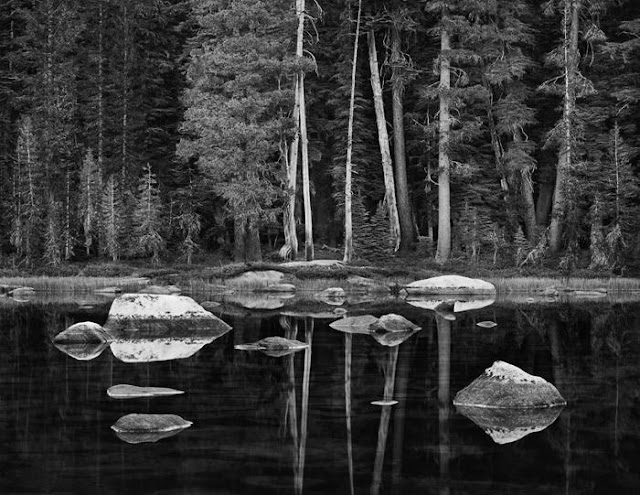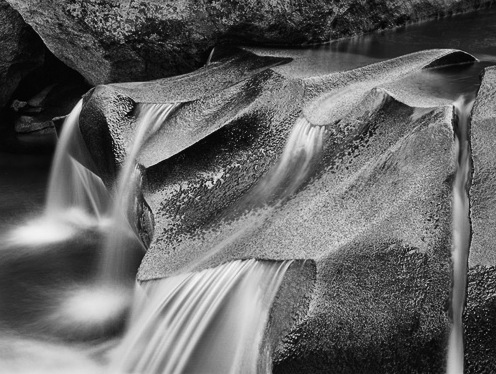Monday, May 22, 2017
Polishing Mirrors: The Photographs of John Sexton
Let me begin this essay with a series of qualifications.
Since the inception of photography in the 19th Century, there has seldom been any doubt about the inherent quality of photography's function, which is its ability to present verifiable versions of visual reality through the use of artificial glass lenses onto light sensitive surfaces. The degree of accuracy of the reproduction of imagery from reflected surfaces, onto flat ones, has always been its aim and measure.
Of course, accuracy alone cannot account for the effect of modified illusions, which is partly what modern photography offers. The last century of photography is the development of a technology of increasing sophistication, in which "raw" data is manipulated and augmented to create altered or improved versions. When Ansel Adams said the negative is the score, and the print is the performance, he was referring not just to the playing of the music, but to its interpretation. What, after all, is a "straight" print, if not one version of the process. To change that process, or adjust it, by whatever means, is in one sense, just another means to an end, which, from an aesthetic point of view, cannot be more or less than an aesthetic choice.
All art is subject to the vagaries of taste, which is ethically neutral. All attempts to fashion a fixed, defensible bastion of aesthetic criteria are doomed, since there is no final arbitration of value inherent in the artistic realm. Which suggests that all our preferences and pronouncements about the ranking of quality in the arts are opportunistic and arbitrary. They may be constructed around humanistic, or religious, or pragmatic principles. They may begin in utter simplicity, but ultimately, we cannot credit such principles unless we accept them, as starting points, as initial axioms.
There have been attempts to distort the meaning and function of photography by diverting it into cup-de-sacs, such as Soft Focus, multiple imaging, etc.; and since the advent of digital technology, the manipulation of the image itself. But there is no reason, other than the arbitration of prejudice, that we should want or need to object to such variations.
Straight photography, nonetheless, continues to hold a place of privilege, even as it evolves into new means and materials. As we transition out of organic emulsions to digital projections, the terms of the equation may change, but the solution to the problem has the same general aim. The sense of an idealized photograph implies the existence of an idealized subject, and this is what makes landscape, fashion, photojournalism and documentation, etc., each in its way, compete for progressively ever more iconic, diverting, or synthetic instances.
What is the difference between reality and an accurate photograph? What is the difference between a "straight" (unmanipulated) print, and one which has been subjected to various augmentations? What is the difference between an "exaggerated" and an "invisible" manipulation? What is the difference between how I see a scene, or a photograph, and how someone else "sees" it? What is "reality"?
Most photographers will readily admit to manipulations, since to do so is as much a boast and a claim, as it is an admission of some degree of artificiality. The delicate balance between a naked "straight" representation and an augmented work, insures that there will always be some degree of "wiggle" room between what we may decide to expect of, or allow, any craftsperson.
The issue of craft is paramount in any production where method and materials are as crucial as they are in the chemical processes of traditional photography. We tend to be somewhat suspicious of any craft that pretends to define meaning and quality merely as aspects of the refinement of technique, as (for instance) with poetry. A well-written sonnet may say nothing of importance, may be nothing but an equivocal demonstration of wit or word-play. But with true crafts, of which photography is one, it is often convenient to think that the perfection of method is more important that the actual content of the image.
John Sexton began his career as an apprentice of Ansel Adams, and his career has followed a familiar pattern for the kind of craftsman that he set out to be, and has become.
It's tempting to suggest that fine art photographers who concentrate, for instance, on landscape can equate fine craftsmanship with the subtle distinctions one encounters in nature. Sexton has said repeatedly that his aim is to transmit the subtlest shades of feeling and impression through the careful exploitation of the finest distinctions of silver gelatin print-making. Like Adams, Sexton focuses on the familiar scenic icons of the American outback, including notably Yosemite, which Adams immortalized.
But unlike Adams, Sexton seems less interested in evoking the "heroic" aspects of nature, than in transmitting meditative calm, peaceful states of mind, fragility, harmony, and centeredness. It is perhaps no coincidence that an adroit technician--patient, careful, even finicky--should choose these kinds of tropes to explore and convey.
What strikes me, looking at Sexton's work, more than any other quality, is its static fragility. It almost has a feminine aspect to it, a timid sufficiency that chooses to accept whatever mildly pleasant scene chance may offer to his discerning eye. His pictures don't seem to say very much. Images of still or silky flowing water, windless forests, posed leaves or rocks or details of architecture seem chosen primarily because they present little challenge, but may yield delicate possibilities in the darkroom.
When technique overshadows content, an artist may become over-fastidious and prone to mannerism. This is what I see in Sexton's work: A photographer who has become so preoccupied with finishing and revising and drawing out nuance and innuendo that he forgets about the importance of feeling and significant meanings.
Any art which gets so caught up in the technicalities of its craft that it forgets to communicate anything but an appreciation of the function has lost its way. Sexton's passivity and ingratiating distillations leave you feeling as if you needed a nap. There is perhaps some use in presenting images of perfect calm and frozen visual music, for those for whom these are the desirable states of mind. We're all familiar with the drugstore Zen Buddhist approach to the vicissitudes of life in the over-amped Western pursuit of pleasure and wealth, but oversimplifying the potentialities of serious photographic-imaging by promoting it as an aid to nature meditation is nothing but glib salesmanship by critics and gallery-owners, looking to capitalize on the latest new age fad.
It may indeed be true that "art makes nothing happen," but whatever is happening should at least occur in the mind of the viewer.
Technique can get you so far in any art, but without at least a clear vision of what your craft is for, you may be nothing but an experimenter, content to let your ingenious tricks be the main attraction of your work.
Sexton's work is restful, and satisfying in a submissive way. Its only determination seems to be to make everything fit, and clear, but that organized transparency feels ungrounded. His prints seem like problems to solve, rather than experiences to be lived.
Subscribe to:
Post Comments (Atom)








1 comment:
In 1984 I attended a photographic workshop at the Asilomar Conference Center in Carmel; it had been organized by the Friends of Photography. I remember presentations being given by John Sexton and Huntington Witherall, and traveling to Morley Baer’s house for a little inspirational talk by Mr. Baer.
I was able to purchase an original print from Sexton, “Ice-Covered Boulders,” (top photo in this post.) I framed it in an aluminum Nielsen frame and had it up for a long time, then unframed it (needed the frame), then recently, found it again. Will probably put it up again.
Post a Comment